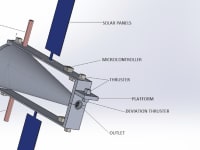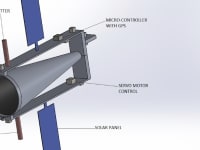
The proposed system represents a novel idea for efficient disposal of space debris present in Low Earth Orbit (LEO). Our system is designed to tackle space debris of the size in the range of 10cm. The main aim of this project is to deflect these medium sized space debris towards the Earth’s atmosphere which will itself serve as a medium for incineration of the debris.
The main body is a modified form of frustum of a cone. The inner surface of the cone is coated with a thick layer of Sorbothane, which is a synthetic visco-elastic urethane polymer having shock absorbing and dampening properties. Four ion based thrusters are mounted on the cone for its manoeuvring. These thrusters are integrated with two Servo motors so that they can be tilted along any of the body frame axis for obtaining maximum controllable degrees of freedom (DOF’s). At the smaller end of the frustum an extended platform is present which carries two deflection thrusters mounted exactly one above the other. Solar panels are used for providing electricity for driving ion thrusters and servo motor. A transmitter and a receiver antenna are mounted on the cone for data communication between the system and the control station.
A Doppler radar is mounted on the larger end of the frustum for detecting the position of the space debris. It is mounted on a rotating platform such that it will be able to detect the debris coming from any direction to avoid collision.
The system will be launched into the LEO from where it will move to the nearest space debris cloud via thrusters whose location will be provided by the ground station. Once the system is in the orbit of the cloud, it will align itself so that its axis matches with that of the incoming space debris with the larger end facing the debris. This detection of the debris is done by Doppler radar sensors whose output will be given to the thruster unit. The system will then bring its velocity close to that of the debris with the help of thrusters making their relative speed to about 10m/s. Once the debris and the frustum of the cone are inline, the debris will enter into the larger end of the cone. Here, as the inside of the cone is coated with Sorbothane, the debris will make collisions with the debris reducing its speed. These collisions will get absorbed by the visco-elastic material. The thrusters will counteract the reactions resulting from these collisions.
As the debris exits the smaller end having diameter twice as that of the maximum permissible debris, and moves towards the cantilever platform, the deflection thrusters will push the debris towards the Earth’s atmosphere where it will burn out due to friction. The reaction produced by this thruster is balanced by the counter thruster placed above it.
The system will again re-position itself according to the position of the next debris as received by the Doppler radar sensors.
-
Awards
-
 2017 Top 10 Most Popular
2017 Top 10 Most Popular
Like this entry?
-
About the Entrant
- Name:Ritesh Deokar
- Type of entry:teamTeam members:Ritesh Deokar Anish Gorantiwar Kunal Nalamwar Krishna Hundekari Rohit Gujarathi Akashay Verma
- Software used for this entry:Solidworks
- Patent status:none








